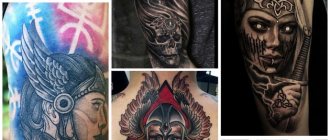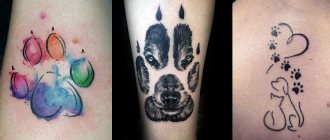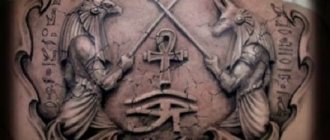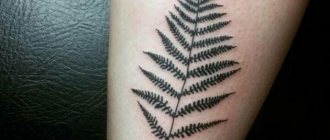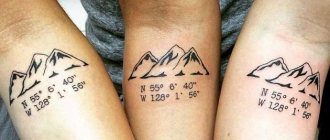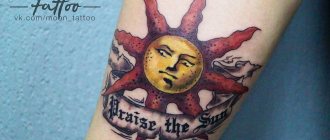Buddha is the main figure of the ancient Eastern religion - Buddhism. The philosophy of this religion is to renounce worldly attachments and achieve nirvana. Buddha tattoos are done by people who are close to the foundations and principles of Buddhist culture. With the help of such a body pattern, they show their affiliation with religion and communicate their life priorities.
Buddha is an exclusively religious symbol. Therefore, tattoos with it are tattooed by representatives of Buddhism or people who use the tenets of the religion as their life concepts.
Buddhist tattoos and their meaning
Buddhism is a widespread religion. Although Buddhists themselves will most likely be offended by the word “religion” and prefer “philosophy.” It is not surprising that in addition to the founder and main teacher, i.e. directly from the Buddha there are many more symbols, each of which has its own secret and sometimes mystical meaning.
- The lion symbolizes royal power. Shows higher authority. In a tattoo, symbolism can reflect a person’s supreme power over himself.
- The Buddhist knot is a symbol of the interconnection of all people in the world.
- Sri Yantra (View photo of tattoo) is one of the oldest symbols. 9 intersecting triangles form an image, the center of which is indicated by a dot. The first mentions of it are found in the Atharva Veda (1.2 thousand years BC). Used for meditation in many schools of yoga and tantrism. It is believed that concentrating attention on this symbol makes the right hemisphere of the brain work more actively (the same one that is responsible for creativity and intuition).
- The Wheel of Dharma is a symbol of the noble eightfold path. The symbol indicates following the path to enlightenment.
- Sitting Hotei is the patron saint of women, brings longevity and prosperity.
- A bodhisattva is a person whose goal is to achieve enlightenment in order to make life easier for all living beings.
- A blossoming lotus (usually in pink) is a symbol of Buddha,
- The Buddha's footprints indicate his constant presence in the world, in the form of various incarnations. Such a tattoo may indicate a desire to follow in the footsteps of your teacher. Also, the Lotus is a symbol of natural purity.
Sometimes, Buddhist tattoos are accompanied by mantras (although, of course, any mantra can be a separate tattoo). The most common one in Russian sounds like this: “O pearl shining in a lotus flower!” This is a translation of the mantra “om mani padme hum.” Despite the apparent simplicity of the mantra, it should not be understood literally, but dissected according to the words:
- “om” is a symbol of the universe;
- “mani” - the desire for awakening, all-encompassing love;
- “padme” - literally a lotus flower, which is a symbol of wisdom;
- "Hum" - indivisibility of practice.
The meaning of Buddhist tattoos.
The main images for tattoos have deep historical roots and are considered traditional not only for Buddhism. It is noteworthy that their meaning has remained virtually unchanged since their formation. Therefore, these images belong to the category of strong energy talismans:
- Buddha tattoo. Gives peace of mind, protects the owner from various dangers, including dark magic;
- Lion tattoo. A symbol of the ruling house and unlimited power. Tattoos are interpreted as a sign that a person controls his emotions;
- Sitting Hotei Tattoo. As a tattoo, it is more suitable for women, since it patronizes the fair half of humanity, bestowing stability and well-being;
- Bodhisattva tattoo. Helps a person achieve enlightenment, use all his strength to achieve the common good;
- Sri Yantra tattoo is one of the most ancient symbols. Responsible for the development of intuition, helps to concentrate during meditation;
- Buddhist knot tattoo. Reminds us of the interconnectedness of the entire world population;
- Wheel of Dharma Tattoo. Suitable for those whose main goal in life is education.
- Tattoo Footprints of Buddha. In a general sense, it refers to the many incarnations of Buddha. In religious terms, it speaks of a person’s readiness to follow in the footsteps of the Great Teacher;
- Lotus Tattoo. A lotus tattoo is suitable for those who want to emphasize the purity of their thoughts;
- King Hong tattoo. Makes a person more sociable and pleasant in communication, helps in trading matters.
In addition to classical images, sacred inscriptions, which can be filled by craftsmen trained in a special technique, are very popular.
Other options for Buddhist tattoos
Among the most common:
- Lovebirds
- Twin Tigers
- Leaping Tiger
- Pig
- Rooster
- Five Buddhas
- Lotus
- Diamond armor
- Ohm
People stuff them for various reasons. Women and girls, desiring harmony and female happiness, decorate themselves with similar designs. Sometimes such pictures speak of awareness of the subtle structure of the world. The woman probably came to this knowledge the hard way. But it often happens that representatives of the fairer sex get Buddhist tattoos only for decoration. In this case, they choose the color option.
Men, trying to “cure” from the past, rethink their views on the world and unsightly actions, choose strict graphic versions of Buddhist tattoos. The owner of such a tattoo often has more than one past mistake behind him. However, sometimes young men who take life lessons seriously and have very definite guidelines for the future decorate themselves with such drawings.
Tattoos with Buddhist content are an excellent choice for decorating the body and acquiring a reliable amulet for good luck and happiness. Whether they were done in a tattoo parlor or by a special Ajyan – it doesn’t matter. The main thing is the meaning given to the tattoo and the attitude of the owner towards it.
Sak Yant, Om Mani Padme Hum, their meaning
A tattoo is a sign-symbol that is applied to the body. Each nationality has its own symbols. History and myths have always been a source for creating tattoo designs. A person could get an ethnic tattoo. Buddhist tattoos are popular nowadays.
Maori tribe
The meaning of the tattoo
The meaning of each tattoo has its own meaning. In general, translated from Polynesian languages, “tattoo” means drawing. Males from the Maori tribe applied body painting to the entire face, women tattooed the lips and decorated the chin.
A tattoo depicting a mantra prayer is not just a drawing, but a symbolic meaning, the embodiment of a mantra, which carries a particularly deep connotation. The meaning of mantra tattoos does not necessarily need to be understood by others.
The word "mantra" means protection of the mind, consists of a series of symbols that evoke a spiritual response in writing, speaking, or singing.
Tattoo "Om Mani Padme Hum"
"Om Mani Padme Hum" is the most common of all Buddhist mantras and is used to invoke the blessings of Chenrezig (Avalokiteshvara, where the Dalai Lama is the embodiment of reincarnation), the Buddhist deity who represents the ultimate compassion. This prayer is repeated as part of meditation.
Om Mani Padme Hum
There is no exact direct translation of this mantra; it is believed to contain all of the Buddha's teachings. Each syllable has a special meaning, symbol and color within the Tibetan script:
"Om Mani Padme Hum."
- Om: generosity (overcomes pride/bliss).
- Ma: Ethics (purifies jealousy/lust for fun).
- Neither: Patience (purifies passion/desire).
- Pad: Hard work (purifies ignorance/prejudice).
- Me: refusal (purifies poverty/possessiveness).
- Hum: wisdom (purifies aggression/hatred).
Om Mani PadmeHum tattoos are more than just words or symbols; they are part of a larger tattoo that includes a lotus flower or are broken down into individual elements.
When each syllable is present, the tattoo is used to focus the wearer on the specific aspect or attribute that the symbol will represent.
Sak Yant Tattoo
Many Hollywood stars prefer Buddhist inscriptions on their bodies. Angelina Jolie has the sacred Buddhist tattoo Sak Yant.
Angelina Jolie
Sak Yant tattoo is very popular in Asian countries like Cambodia. The meaning of Sak Yant is a prayer or blessing sent to the person on whose body it is drawn. Translated from the ancient Sanskrit language, Sak Yant means “a sacred geometric pattern that contains sacred geometric symbolism.
Sak Yant
Sacred tattoos
- Amnai - the owner of such a tattoo should receive power, which should force other people to respect its bearer, help him subjugate them to himself.
- Sath Himapant allows a man to obtain properties characteristic of any animal.
- Mattha Mahanyom - a sign that helps its bearer to receive compassion from others also increases the fame of the owner of the sacred sign. Chok Laap - a symbol of good luck and a happy future. Kong Grapan Chatri - protects against gunshot wounds.
- Maha Sanae - a tattoo is designed to help achieve the attention of an individual of the opposite sex, which the bearer of the tattoo likes. Clave Treasure - places a block on death or danger.
- There Kvaam - a tattoo related to black magic rituals, can be used by a man to make his mistress leave her husband. This symbolic design is also supposed to inflict a fatal disease on the enemy, and can help win a legal dispute, which is why it is very popular among lawyers.
- Jang Ngang - can lead to paralysis; the enemy of the tattoo owner stops reacting and is stunned.
Buddhist monks are still prohibited from giving tattoos to girls. Representatives of the fair sex have the right to get a tattoo only by a professional artist who is not a Buddhist. Nong Khim Monastery in Chiang Mai is famous for its tattoo artists.
Meaning of tattoo
This is where the most famous “temple tattoos” are done. Ajahn - the master has the right to pass on his skills to students; any person wearing an Ajahn tattoo can be considered a student.
Prices for Sak Yant vary widely. It all depends on how popular the master who makes them has become. The price of the author’s work depends on how many white tourists the artist has already tattooed.
If a Buddhist motif is written around or inside the design, then such a tattoo is usually called “Kata”. Translated, this word means prayer.
First mentions of Sak Yant
Naresuan Maharaja is an ancient king who headed Attyuhai, it was during his reign that the first mentions of Sak Yant were noticed. The warriors of the Attyuhai kingdom applied Sak Yant tattoos to themselves as amulets that were supposed to protect them from the enemy sword.
The warriors wore special Sueayant shirts; they had to repel enemy blows, thanks to special formulas applied to them. In order to activate the power of Yant, you need to recite the “kata”.
A person who wears a sacred tattoo is required to observe a number of mandatory principles and commandments of Sin Haa.
- Don't kill.
- Don't steal.
- Don't lie.
- Don't commit adultery.
- Don't drink alcohol.
These rules must be decisive in the life of every Buddhist.
The moral purity of a Buddhist who observes these precepts should help him maintain inner strength.
Sak-yants remain a completely unknown part of the life and culture of the local population for tourists.
nagadali.ru
Meaning for women
Tattoos with Buddha for women mean nothing more than the desire to master spiritual tranquility, or to comprehend religious subtleties. Such women, striving to go through the path of purification, can “stuff” the Buddha, or the Buddha with a lotus or on a lotus.
More about Thor: Perunitsa
As the practice of tattoo artists shows, representatives of the fair sex choose a tattoo with Buddha because of beauty, and not because of religion. Tibetan tattoos are popular among girls.
Meaning for men
The charismatic personification of the image of Buddha in a tattoo is often the choice of men, both East and West. The stronger sex is inclined towards images in the style of realism (tattoos that are as similar as possible to real objects).
Similar tattoos for men can mean:
- passion for the culture of the East, philosophical meaning
- Finding spiritual peace and getting rid of suffering
- religion
- desire for purification.
A Buddha tattoo on a man lets others know about the pure thoughts of the owner, as well as the desire to prevent suffering.
But it is worth noting that everyone has their own views. Some are inclined to become imbued with the philosophy of Buddhism and note for themselves the specific aspects of this movement, while others simply like the traces of Buddha on their body.
Symbol meaning
As written above, Buddha was a teacher. He believed that everyone could achieve enlightenment and nirvana. And he did not require special treatment. A tattoo with the image of Buddha carries the main meaning of the philosophy of Buddhism. Getting rid of suffering is the main goal of a person in his life. A tattoo of a meditating Buddha symbolizes the desire to find harmony and balance in everything, deepening into oneself.
The main motive is the perception of reality as it is. Without interference or deviation from the truth. The image of a laughing Buddha is the personification of prosperity and happiness. The head of the Buddha is a kind of amulet that helps to show wisdom and patience. The folded hands of the Buddha symbolize contemplation.
The meaning of the drawing
The meaning of a Buddha tattoo is associated with the story of a spiritual mentor. This is compassion, wisdom and freedom. A person with a religious tattoo expresses his respect to the teacher and shows others his commitment to Buddhism. The owner of the drawing strives to achieve enlightenment, get out of the series of constantly alternating life and death, and plunge into nirvana. Such a person knows how to sympathize, avoids quarrels, and strives for a modest lifestyle. In the world you can find many designs of Buddha tattoos.
Variants of the image of the thinker have different meanings:
- hands of the teacher - contemplation;
- Buddha in the process of meditation - inner harmony;
- the thinker's head is a sign of wisdom;
- joyful enlightened one (hotei) – happy life, wealth.
Buddha tattoo meaning
A person who decides to get a tattoo shows his affiliation with Buddhism. He is close to the meanings and postulates put forward by this religion. The main goal that Buddhists promote is liberation from karma: getting rid of desires and suffering. That is, what a person gives is what he receives. A kind of cycle. Those who come out of the ill-fated karmic circle find nirvana.
Of course, many people choose a tattoo without relying on the meaning. They are guided by aesthetic ideals, so the image of Buddha can be found on people who are completely far from this philosophy.
After all, there is always a category of people who strive to stand out from the crowd in an original way. To do this, they choose images that are sure to grab people's attention. In this way they show their exclusivity, as well as their way of thinking, which is radically different from the crowd. We can say with confidence that the image of Buddha on the body will not go unnoticed.
How to choose a place for a tattoo.
Sketches of Buddhist tattoos can be seen all over the body. Large-scale paintings adorn the backs, and images of Buddha are applied as sleeves. Tattoos with animal elements are placed on the lower leg.
The Dharma Wheel, as well as compact mantras, can be placed on the wrist, neck, shoulder or chest. Sak Yant, as the most sacred tattoo, is rarely placed below the waist. Although there are very nice options on the leg above the ankle. In addition, a professional artist (in the east, monks are most often involved in applying Sak Yant) will tell you where it is best to place tattoos of Buddhist symbols, for each of which there is already a default place.
Great Buddha
Of course, the most popular Buddhist tattoo is the image of the founder of this faith - Buddha. It carries several meanings and generally acts as a talisman for its owner. The main message of the Buddha image is faith in the best, enlightenment, abundance and good luck. This, according to Buddhists, is the most important criteria of human life. In the photo below you can see what a sketch of a Buddhist tattoo looks like.
There can be a great many variations of the Buddha image. And also, if desired, its size and color scheme can be selected. Usually the Buddha is depicted surrounded by other positive amulets of Buddhist practice. Thus, the power of the tattoo increases several times more.
Buddha tattoo locations
For Buddha tattoos, it is recommended to choose body parts such as the back, chest, and stomach. You can also use shoulders and forearms for smaller tattoos.
In such places, the painted drawings associated with the Buddha look more dynamic and rich, especially if the realism style is chosen.
On the back you can choose either two designs or one large one. With this option, the tattoo artist makes great efforts to ensure the clarity of the future tattoo, because with such a large area you can “stuff” many details, including a lotus, a wheel and the Buddha himself.
A drawing that is pleasing to the eye is a lotus painted in watercolor on the shin. Either a golden Buddha on the back or chest.
More about the Torah: Slavic amulets: types and meanings
Not much history
Convinced that Siddhartha (Buddha) would soon appear as the greatest king, his father protected him from external influence and especially from religion and the knowledge of suffering. Although his father provided everything for a royal life, Siddhartha felt unhappy and realized the falsity of his life.
By the age of thirty, Siddhartha left his home. Soon he saw four disadvantaged people who influenced his future life: a beggar, a sick man, a decaying corpse and a homeless man.
He realized the harshness of life - that illness, death, aging and suffering are inevitable. He realized that neither wealth nor fame will protect from suffering and that the path of truth and knowledge is the only help on the path to reaching the origins of suffering.
Dangerous tattoo.
In Buddhism itself there is no call to decorate the skin with drawings. However, as well as prohibitions on wearing tattoos with Buddhist themes. Only Tibetans disapprove of this practice, claiming that tattoos prevent the soul from leaving the body and going into the sacred world at the time of death.
But what you should be wary of in the countries of East Asia is not spirits from the world of subtle matter, but very real local residents. Not all representatives of Buddhism have a positive attitude towards non-believers who fill themselves with images of the Great Teacher or symbols sacred to Buddhists.
In Thailand, there have already been cases of delays at customs due to the image of Buddha in the form of a tattoo. Today, they want to legitimize the ban on foreigners depicting symbols that are iconic for Buddhists at the state level.
Lotus
Girls, as the most delicate creatures on the planet, prefer to decorate their bodies with flowers. When it comes to Buddhist-style tattoos, the choice often falls on the lotus. According to legends, it is believed that a woman who chooses stuffing in the form of a blossoming lotus flower strives to be wiser, as well as to find peace of mind and harmony with the world. In addition, Buddhists believe that the lotus is a symbol of true purity and purity.
Like any tattoo, there is not and cannot be a specific place where the lotus is applied. Its location and shape of the flower image depends on the personal desire of the owner. Professional craftsmen offer their clients sketches of a lotus with oriental patterns on the petals, in a minimalist style or graphics.
An interesting fact is that the chosen shade of the flower also matters. For example, a white lotus is able to protect its owner on a spiritual level, a red lotus indicates a woman’s crystal-clear soul, and a blue lotus symbolizes the desire for wisdom and the desire to comprehend the truth of human life.
Popular sketches.
For those who have decided to get a Buddhist tattoo, artists provide a wide selection of designs of varying sizes and complexity. In most cases, the central position in the tattoo will be occupied by the image of Buddha, or one of his incarnations.
The most popular among Europeans (not counting images of Buddha) are Hotei, elephant, lotus and the wheel of Dharma. Most often these are large-sized full-color tattoos. Although recently there has been a tendency towards more modest monochrome options and laconic depictions of objects.
It is worth mentioning separately about the image of mantras. The most popular in this series is the short mantra Om. Although there are options for writing longer texts, the choice of which will depend solely on the preferences of the carrier.
Sak yant.
The religious painting Sak Yant is perceived as a tattoo amulet. It is performed in the Khmer and Thai alphabet and consists of short mantras. Until recently, only a man could become a Sak Yant master; tattoos were never given to women. Today, no one follows these rules anymore.
The technique of applying Yant is interesting: the paint is injected under the skin using a sharply sharpened bamboo stem. According to tradition, the master must continuously chant mantras while working. And after applying the tattoo, tell the truths that are important for Buddhists.
Sak Yant has never been considered as an ordinary tattoo. First of all, it is a powerful magical talisman. The catch is that the tattoo will enhance the dominant aspects of a person. Therefore, the choice of such a tattoo indicates complete readiness for intense and painstaking work on oneself.
The most common types are:
- Amnai. Tattoo of power. Gives strength and suppresses the will of others;
- There's Kvaam. Helps to make wishes come true, including terrible ones;
- Maha Sanae. Responsible for love relationships;
- Kong Grapan Chatri. One of the most useful tattoos. Its presence makes a person invulnerable to any type of weapon. At least Buddhists believe so;
- Giang Ngang. Tattoos of professional fighters.
- Sath Himapant. The owner of such a tattoo can adopt the abilities of animals
For Buddhists, Yants are not just tattoos done for fun. They carry deep meaning, help cope with difficult situations and can completely change a person’s destiny. Therefore, the decision to get such a tattoo should be balanced and deliberate.
Thailand monk tattoos
In eastern countries there is such a thing as tattoos of Buddhist monks called Yanttra. Their essence lies in the magical influence on the person on whom they are applied. The tattoo itself represents ancient patterns mixed with Buddhist prayers.
Yanttra is made manually using a metal needle with ink. In order to get such a tattoo, everyone goes to the temples of Thailand, where this type of protection is practiced.
In each of these temples, there is a monk who does this work. By going through a special ritual and making small donations to the temple, you can become the owner of this magical tattoo in just 30 minutes.
The sketch is chosen by the monk-tattoo master himself, depending on what kind of protection you want to receive and depict on your body. Regarding the sanitary condition and safety of Yanttra, there is indeed a risk of infection. Because generally the conditions where monks get these tattoos done are somewhat unsafe. However, it seems that this point does not confuse the temple guests, who come every day for a new amulet.
Buddha tattoo symbolism
The Buddha tattoo represents a spiritual or religious connection with Buddha Shakyamuni, the founder of Buddhism. Tattoos of this theme are often applied to the body, having nothing in common with Buddhism.
More about Thor: Amulet tattoos for girls and men: meaning and photo. How to choose a tattoo wisely?
It is believed that applying Buddhist symbols to the arms, shoulders, back and lower body:
- wheel of dharma
- sacred lotus
Buddhist signs applied by monks is a kind of trend.
Dharma wheel tattoo on back
However, no matter how popular the trend is, supporters of Buddhism would not be very happy with the face of the sacred Buddha on the thigh or in an intimate place.
This is even punishable by law. So if you intend to decorate your body with tattoos of eastern symbols, then it is worth taking into account the feelings of religious supporters.
Indian tattoos-amulets
The Indians were convinced that the intertwined threads of the pattern could stop any evil spirit and save a person from their influence. Complex patterns were drawn on the bodies, feathers were woven into the faces of deities and shared with totem animals. Drawings were applied to the neck, shoulders, back - places close to the head.
An Indian tattoo should be done if the Indian culture is close to you and then it will act as a talisman.
| The dream catcher was not only hung over the bed, but also tattooed on the body to protect oneself from evil spirits. |
| Kokopelli is the main deity of the Indian tribes after Manitou. A creature with a flute brought only benefits - it protected against wounds and injuries, difficult childbirth, and brought prosperity and success to adventurers and adventurers. |
| The reason for the popularity of tattoos with the face of an Indian is still not known for certain. Beliefs say that such a tattoo served as a talisman against poverty, ill health and failure in amorous affairs. |
| as totem animal, and the application of such a tattoo personified the character of the owner and imparted those qualities that he lacked. Thus, the wolf served as a talisman of fidelity, perseverance and intuition, the coyote - cunning, the bull - desperate courage, the bear - strength and courage, the eagle - power and vigilance. |
| the feather served as a symbol of eternal life and constant rebirth, so only leaders and important people - shamans and warriors, who thus established a connection with the gods, could wear such a tattoo. And eagle feathers conveyed the courage, strength and speed of the bird. |
Buddha tattoo styles and combinations
There are numerous options for Buddha tattoos. Often, both women and men make an accentuated choice of a beautiful image in watercolor style.
Such tattoos look rich and resemble watercolor paintings. You can paint lotus flowers in watercolors. As well as various oriental patterns.
An equally impressive choice could be tattoos made in the style of realism. They look impressive on both rough male and delicate female bodies. Such tattoos stand out for their richness and naturalness.
New school style is often the choice of women. The style is distinguished by its peculiar convexity and colorful colors.
To demonstrate religious tattoos, designs depicting a palm or a footprint are often chosen.
Buddha tattoo
The image of Buddha is a sign of peace and contemplation of all things.
His real name is Siddhartha Gautama. This man lived in the 16th century BC. And they called him that because one day he voluntarily became a hermit and devoted most of his time to cultivating his soul, enlightenment and knowledge of the world.
Often the tattoo depicts more than one founder of Buddhism, but with additional elements - plants or birds. Particularly successful areas for placing such a pattern on the body are the back, chest, and forearm. You should get a tattoo on your back if you plan to use a large area of the body.
There is a rule for all applied objects in this style - the zone for them can be any part of the body above the waist. This unspoken law is due to the fact that in Eastern beliefs and philosophy, the feet are the dirtiest part. And images such as Buddha cannot be brought close to human feet.
It is worth noting that Buddha is not God. He is the founder of the philosophy of life. This mentor, as a symbol of a pure soul, is designed to help people not to chase material values and to cleanse themselves from the daily bustle. To be in a state of nirvana means to enjoy existence itself, without attachments and obsessive goals.
An image of Gautama can be painted on himself by any person who is close to the karmic philosophy of Buddhism. And according to it, what you send to the world is what the world returns to you. The tattoo can be in monochrome or color. If a lotus flower is depicted together with Buddha, this signifies the purity of thoughts of the person wearing such a tattoo.
Who is Buddha?
The prince was born into a royal family on the border of Nepal and India. The father wanted to protect Siddhartha from any troubles and suffering in life. So that the son would not learn about the existence of beggars, sick and old people, they were expelled from the palace in which the future Buddha lived. However, at the age of 30, Siddhartha left his home and discovered 4 things that changed his worldview: a dead body, an old beggar, a leper patient and a hermit. What he saw amazed the future Buddha, and he left his family, home and property to find a way to deliver a person from suffering.
Being a hermit, Siddhartha Gautama studied meditation from the enlightened. But this did not help him achieve the desired state. Then he rejected the teachers and began searching for nirvana in his own mind. Siddhartha vowed to sit under the Bodhi tree until he achieved liberation. A state surpassing everything in the world came to the Buddha after 40 days. For the rest of his life, Siddhartha traveled throughout northern India and spread knowledge. Buddha was not a god, as he told his disciples. Now the religion has a huge number of followers in all parts of the world.
